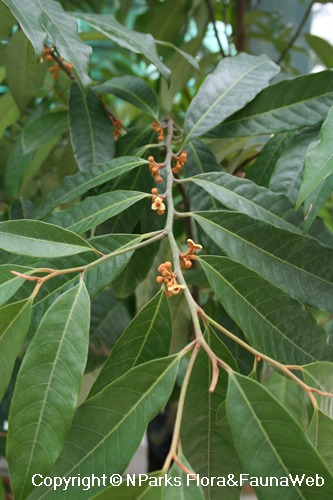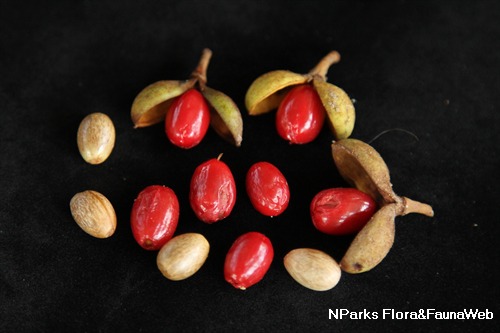.jpg)
Back
Knema furfuracea (Hook.f. & Thomson) Warb.
| Family Name: | Myristicaceae |
| Synonyms: | Myristica furfuracea Hook.f. & Thomson |
| Common Name: | Wild Nutmeg, Pala Hutan, Penarahan |
Knema furfuracea or Wild Nutmeg is a tree that grows up to 25 m tall. It is a native tree with young twigs which start off light brown, covered in dense hair-like scales which soon rub off. Fresh leaves are white in colour, while mature leaves are dark green above, dull below. They are oblong to lanceolate, with a pointed tip and square to heart-shaped base. Flowers buds are 3- 4 lobed, either yellow, red or pink coloured produced on the axils of the foliage. Fruit is brown to apricot coloured, oval to almost round covered in rust-brown hairs.
Name
Classifications and Characteristics
| Plant Division | Angiosperms (Flowering Seed Plants) (Dicotyledon) |
|---|---|
| Plant Growth Form | Tree |
| Lifespan (in Singapore) | Perennial |
| Plant Shape | Pyramidal |
| Maximum Height | 25 m |
Biogeography
| Native Distribution | Malaya, Sumatra, Thailand & Singapore |
|---|---|
| Native Habitat | Terrestrial |
| Preferred Climate Zone | Tropical |
| Local Conservation Status | Native to Singapore (Critically Endangered (CR)) |
Description and Ethnobotany
| Growth Form | It is a tree that grows up to 25 m tall with a pyramidal crown and greyish brown flaky bark. Young twigs start off light brown covered in dense hair-like scales that are soon rubbed off, turning blackish. |
|---|---|
| Foliage | Its alternate and stalked leaves are leathery, oblong to lanceolate in shape measuring 10 - 50 cm by 3 - 21 cm, foliage widest at the middle. Leaves are dark green above, dull green below with a golden brown midrib raised on both sides. Each leaf has a pointed tip with square (truncate) to heart-shaped (cordate) base. |
| Flowers | The flowers are dioecious, producing female and male inflorescence on separate individuals. Each stalkless cluster is axillary, bears between 3 - 30 male flowers or up to 20 female flowers. Flower buds are yellow, pink, red or deep red inside with 3 to 4 lobes. |
| Fruit | Its fruit is oval to almost round in shape, covered in rust-brown hairs. Each cluster contains up to 4 reddish brown to apricot coloured fruits measuring between 2.5 - 3.5 cm by 2 - 2.8 cm. Each fruit contains 1 seed enclosed in a bright red, fleshy covering (aril). |
| Habitat | Occurs in primary and degraded rainforest, on hillsides and ridges, over granite, limestones, on clayey and black soil. |
| Etymology | Its species epithet 'furfuracea' derived from the latin name furfuraceus - like bran, in reference to the persistent, short scales found on the leaves. |
Plant Care and Propagation
| Light Preference | Full Sun, Semi-Shade |
|---|---|
| Water Preference | Moderate Water |
| Plant Growth Rate | Slow |
| Rootzone Tolerance | Fertile Loamy Soils, Moist Soils, Well-Drained Soils |
| Propagation Method | Seed |
Foliar
| Foliage Retention | Evergreen |
|---|---|
| Mature Foliage Colour(s) | Green |
| Mature Foliage Texture(s) | Glossy / Shiny |
| Prominent Young Flush Colour(s) | White, Yellow / Golden |
| Foliar Type | Simple / Unifoliate |
| Foliar Arrangement Along Stem | Alternate |
| Foliar Attachment to Stem | Petiolate |
| Foliar Shape(s) | |
| Foliar Venation | Pinnate / Net |
| Foliar Apex - Tip | Acuminate, Acute |
| Foliar Base | Cordate, Truncate / Square |
Floral (Angiosperm)
| Flower & Plant Sexuality | Unisexual Flowers, Dioecious |
| Flower Colour(s) | Yellow / Golden, Pink, Red |
|---|
| Flower Grouping | Cluster / Inflorescence |
| Flower Location | Axillary |
| Flower Symmetry | Radial |
Fruit, Seed and Spore
| Mature Fruit Colour(s) | Yellow / Golden |
|---|---|
| Mature Fruit Texture(s) | Velvety / Furry / Tomentose |
| Fruit Classification | Simple Fruit |
| Fruit Type | |
| Seed Quantity Per Fruit | Few (1-5) |
References
| References | Royal Botanic Gardens, Kew (continuously updated). Plants of the World Online | Kew Science. https://powo.science.kew.org/taxon/urn:lsid:ipni.org:names:585857-1. Accessed 05 July 2022. de Wilde, W.J.J.O (2000). Myristicaceae. Flora Malesiana - Series 1, Seed Plants, Vol. 14, pp. 258-259. |
|---|
Image Repository
Others
| Master ID | 34234 |
|---|---|
| Species ID | 8647 |
| Flora Disclaimer | The information in this website has been compiled from reliable sources, such as reference works on medicinal plants. It is not a substitute for medical advice or treatment and NParks does not purport to provide any medical advice. Readers should always consult his/her physician before using or consuming a plant for medicinal purposes. |

.jpg)
.jpg)
.jpg)
.jpg)
.jpg)



.jpg)